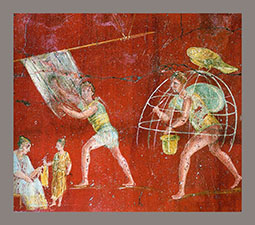Autore: F. Coletti
Scarica l’articolo in formato .pdf: I tessuti d’area vesuviana del Museo Archeologico Regionale di Palermo. Indagini tecniche e analisi archeometriche
 La presente ricerca si inserisce all’interno di un ambizioso progetto condotto dall’Università degli Studi di Palermo in collaborazione con il Museo Archeologico “Antonio Salinas” relativo allo studio e all’analisi dei reperti donati al Museo nella prima metà dell’Ottocento dalla Casa Borbone. Il contributo intende presentare i risultati delle analisi svolte su una serie di reperti organici, i quali si sono potuti identificare come resti di tessuti carbonizzati. Le indagini microscopiche hanno reso possibile individuare il tipo di tessuti e le fibre impiegate per la produzione dei filati, come anche caratterizzare i diversi stadi di carbonizzazione dei reperti. Confronti interessanti, dal punto di vista della modalità di preservazione dei tessuti e della loro funzione, si sono potuti istituire con le già note collezioni tessili vesuviane e le impronte di indumenti impresse sulla superficie dei calchi in gesso delle vittime di Pompei. Gli esiti di questo studio si inseriscono in un progetto interdisciplinare che, oltre alla ricerca scientifica, si prefigge lo scopo di valorizzare ed esporre i reperti delle donazioni borboniche presso il Museo di Palermo.
La presente ricerca si inserisce all’interno di un ambizioso progetto condotto dall’Università degli Studi di Palermo in collaborazione con il Museo Archeologico “Antonio Salinas” relativo allo studio e all’analisi dei reperti donati al Museo nella prima metà dell’Ottocento dalla Casa Borbone. Il contributo intende presentare i risultati delle analisi svolte su una serie di reperti organici, i quali si sono potuti identificare come resti di tessuti carbonizzati. Le indagini microscopiche hanno reso possibile individuare il tipo di tessuti e le fibre impiegate per la produzione dei filati, come anche caratterizzare i diversi stadi di carbonizzazione dei reperti. Confronti interessanti, dal punto di vista della modalità di preservazione dei tessuti e della loro funzione, si sono potuti istituire con le già note collezioni tessili vesuviane e le impronte di indumenti impresse sulla superficie dei calchi in gesso delle vittime di Pompei. Gli esiti di questo studio si inseriscono in un progetto interdisciplinare che, oltre alla ricerca scientifica, si prefigge lo scopo di valorizzare ed esporre i reperti delle donazioni borboniche presso il Museo di Palermo.
The present research is part of an ambitious project conducted by Palermo University in collaboration with the Palermo Museum “Antonio Salinas”, focusing on the study and analysis of the artefacts donated to the Museum in the first half of the 19th century by the Borbone dynasty. This contribution aims to present the results of the analyses carried out on a series of organic artefacts identified as remains of carbonised textiles. Microscopic investigations allow for identifying the textile structures, the type of fibres and the characterisation of various stages of carbonisation of the textile materials. Interesting comparisons concerning the preservation states and the original function of the textile fragments have been established with the Vesuvian textile collections and the imprints of garments impressed on the surface of human plaster casts of Pompeii. The outcomes of this study contribute to an interdisciplinary project that aims, in addition to research, at the enhancement and display of these artefacts undertaken by the Palermo Museum concerning the Borbone donations.
